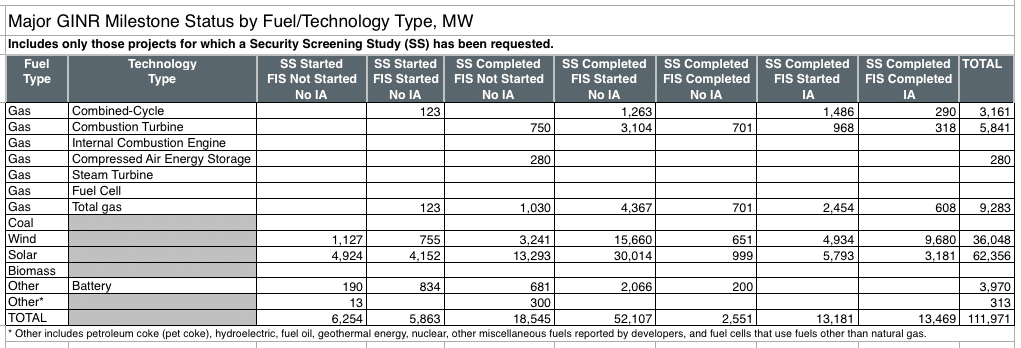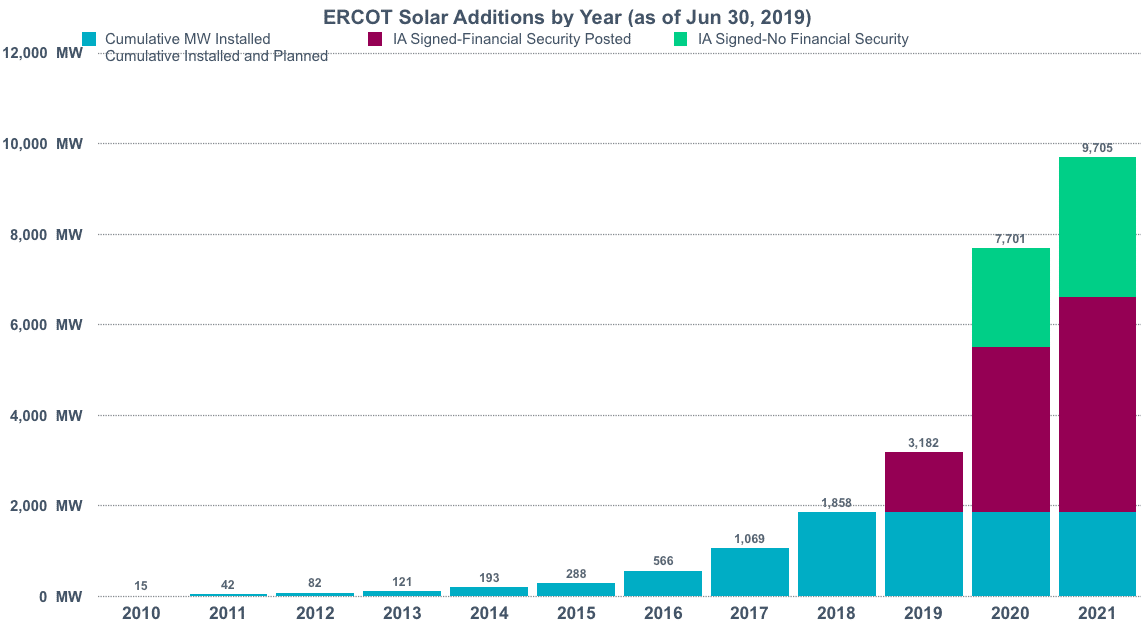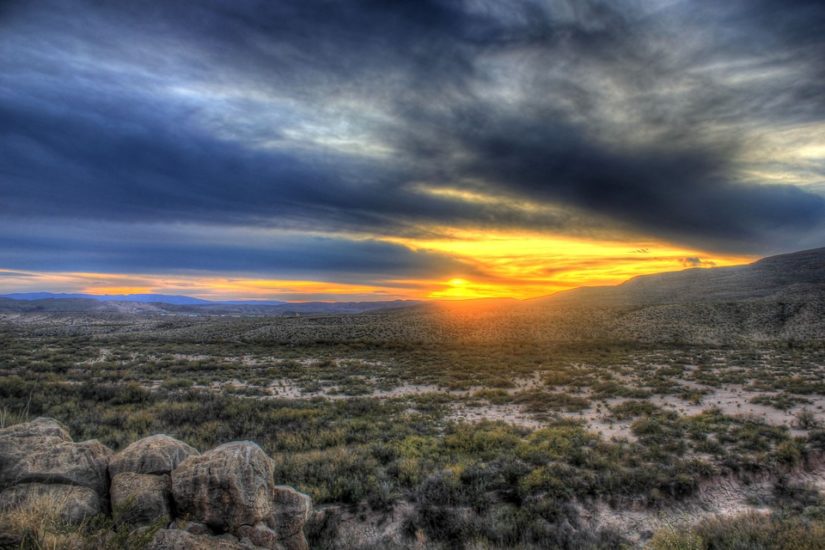It was hot yesterday in Texas. Really hot; 105 in Austin and San Antonio, with a heat index that made it feel much worse than that. And with the state’s economy and air conditioners buzzing away, demand on the electric grid hit a new all-time high of 74.5 GW between four and five PM, a fact noted the the Electric Reliability Council of Texas (ERCOT).
ERCOT set another new all-time peak demand record today, reaching 74,531 MW between 4 and 5 p.m. This surpasses the record set earlier this afternoon by 368 MW. View actual loads: https://t.co/PsQRlROs1l pic.twitter.com/KA2f44iAHd
— ERCOT (@ERCOT_ISO) August 12, 2019
This was both 1 GW higher than the all-time record set last summer and above the state’s forecast for the day, and fairly close to the 78.9 GW of total generation capacity (including reserves) that the state identified in May as being available this summer.
But while ERCOT was expecting something like this to come, it still sent wholesale power prices shooting up above $7,500 per megawatt-hour, before even 3 PM.
https://twitter.com/AlexKlaessig/status/1161002669638606849
This was a test of Texas’ power system, which has no capacity market and is characterized by slim reserve margins. Earlier this spring, ERCOT identified that the system might need to enter an emergency status in order to keep the lights on.
And while Texas passed this test, with no widespread reports of power outages, it remains to be seen what next summer will bring.
Can solar meet the peak?
One resource that could help to meet this peak demand is solar, particularly when paired with energy storage. But given its size, wealth of cheap land and ample sun, Texas has less solar than you would expect. ERCOT’s summer resource adequacy report, published in May, identified less than 1.9 GW of utility-scale solar.
There is also a question of how much solar is able to meet these peaks, which come well after the mid-day peak of solar generation. In San Angelo, Texas, which is around the geographical mid-point of the western half of the state, the sun didn’t set until around 8:30 PM yesterday, but that doesn’t mean that solar projects – particularly those on rooftops and fixed-tilt racking – are at full output.
ERCOT gives a peak average capacity percentage of 74% for large-scale solar, meaning that it expects solar to have an average generation of around 3/4 of its rated capacity at the time of peak demand. But one of the challenges here is that these peaks typically run for several hours. ERCOT’s total demand yesterday was more than 70 GW until 8 PM, and didn’t fall below 60 GW until around 11 PM.

Solar paired with four-hour lithium-ion batteries could neatly meet this peak evening need, including after the sun goes down. And this is not theory; the Hawaiian island of Kaua’i is doing exactly this with large-scale solar paired with batteries, and the rest of Hawaii has followed suit – procuring 247 MW of solar projects backed with 998 megawatt-hour of battery storage. Notably, these all came in with bids of under 10 cents per kilowatt-hour.
The queue
If Texas doesn’t yet have as much solar as it could use, it is farther behind on batteries. The same May report which showed the 1.86 GW of solar also showed only 86.5 MW of batteries, and the state’s laws around ownership of battery storage could be an issue here.
There is a truly awesome amount of solar on the way in Texas, with ERCOT’s July interconnection report showing 62 GW of solar projects. And while given the highly speculative nature of project development most of those will likely not be built, there are nearly 9 GW of projects that have interconnection agreements, including 3.2 GW that have a full interconnection study completed.

Those projects that can secure financing and get built will come online over the next few years. It is difficult to say which ones will be online by next summer, but a June ERCOT report identified 1.3 GW of projects with interconnection agreements and financial security posted that are expected to come online later this year, a number which should grow as the year progresses.

Batteries are less promising; while there are nearly 4 GW of battery projects in the queue, none of these yet have interconnection agreements.
Nor do we know what the weather will be like next summer, but with increasing temperatures due to climate change, there is a good likelihood of Texas continuing to ramp up its peak demand as more and more air conditioners crank up to deal with the heat. It will be a race to get enough solar, and batteries, online in time.
This content is protected by copyright and may not be reused. If you want to cooperate with us and would like to reuse some of our content, please contact: editors@pv-magazine.com.









Texas has fought tooth and nail against renewables except for corporate entities. One solution that’s been proposed for years and denied is met metering. Also slow waking interconnecting rooftop solar system, permitting etc. has made growth slow, as well as making it as difficult as possible to acquire rooftop solar, through leasing or other means. This has slowly been changing. Very slowly! As a resident and homeowner in Texas, I know personally how difficult it can be. Roadblocks, hoops, red tape, HOA design requirements, and a slew of other issues make it difficult and expensive.
My home is prime for rooftop solar. South facing, clear of obstructions, etc. It takes up to 6 months after installation to be grid connected, inspected and so on. Centerpoint Energy is one of the biggest obstacles, and biggest lobbyists in the state, along with Reliant and NRG, TXU and other big providers! Centerpoint owns 100% of our local infrastructure and we have to pay them interconnect fees, just as we have to pay fees through our provider to Centerpoint.
Electricity is fairly inexpensive where I live, but is triple compared to my brother’s municipal utility service in another large Texas city, mainly because of added fees and other deregulation costs. This is just another disincentive to adding rooftop solar. Easier access to rooftop solar would eliminate ERCOT’s peaks.
It was 102 today where I live with a heat index of 1112. It’s been like this now for a week, with great indexes of 105+ for nearly 7 weeks. Last week the heat index hit 117. This doesn’t sound too bad for dessert communities, but the high humidity masks it unbearable and forces air conditioning systems to work harder using more power to keep it cool, It’s similar to us thinking 2 inches of rain an hour that causes flash flooding as being nothing and because when it rains here that’s mild, considering we got five feet in a couple of days!
Bottom line is there’s a whole lot more Texas could be doing to solve the problem, but won’t because we minions don’t have millions to donate! Those with money really do have power in Texas. Those without are at the mercy of those who do. There are few restrictions on such things in Texas!
Wow. That heat sounds terrible.
More rooftop solar would help with the early part of the peak, but to really be effective it needs to be paired with batteries. The peaks are lasting until well after sundown.
From MSN on this very topic: “The prospect of supply shortages sent wholesale electricity prices surging past $9,000 a megawatt-hour for several minutes, triggering a limit set by Ercot to avoid runaway prices during extreme events. They remained near the cap at around 5 p.m. local time as demand began leveling off and the region’s supply margins widened.”
So, it started at three at $7,500/ MWh or $7.50/kWh, ended up at $9,000/MWh or $9.00/kWh. With a 5 ton air conditioning running for just those two hours could have cost the homeowner $108.5 dollars for such a short time. If you have such incidences all month long one can expect thirty days worth of $3255.00 plus what ever the “regular” cost per kWh usually is. Oh yeah, solar PV with smart energy storage is needed in Texas. ERCOT is stumbling, you need at least 25% stored energy to help keep that grid up and prices down. Basically all you need is a few days like this and $1500 a month electric bill is ‘normal’.
The $108.50 claim would be true *if* wholesale electricity prices were passed directly on to consumers. I haven’t looked at Texas’ residential billing, but I’ve seen no place where that is done. I doubt utilities even have the technology in place to translate 15-minute or hourly wholesale pricing directly to residential consumers; if they did ratepayer advocates and regulators would not let them.
Instead, what we are looking at is higher electric rates spread over the monthly bill.
In Texas we have flat rate energy rates. The wholesale increases aren’t passed on directly to consumers. I’m in Texas, I know first hand. I got an ERCOT requesting reduced consumption because our closed system isn’t able to meet possible peak demand. This happens both when it’s extremely hot, as now, or extremely cold. This is because thermal plants have difficulty producing electricity during extreme temps, high and low. During the last few extreme winters, Texas was only able to keep the lights on was because of renewables, namely wind. Until a recent court decision, the renewable storage market was a quagmire at best and nearly prohibited at its worst. Plus this is oil country! And that’s the big fight! Oil coal and nuclear are the preferred corporate and political generation in Texas, but with lt Gov Patrick and Gov Abbott, it’s a tough row to hoe. Our politicians can be legally bought by corporations and lobbyists! Rick Perry was a perfect example of this. Oil is king in West Texas where solar and wind are best suited. The Permian Basin is the oil Mecca of the U.S.., even though oil, wind and solar can coexist on the same land. Eagle Ford Shale play is another.
I spent my entire life in oil country, raised with oil money. From Louisiana to California, North to Alaska, oil was always there for us, and I know directly how these oil companies, not just the big ones everyone knows, but the small, independent drillers, producers, servicing companies, frackers, waste management companies, injection companies, and even safety and environmental and engineering and geological companies all lobby against renewables. They aren’t necessarily climate deniers, but all worship at the alter of money. Money now. And the people they hire to do the dirty work are easily manipulated into believing the rhetoric coming from above about hoaxes, fake news, fake scientists, blah blah blah. These people don’t know or understand the benefits of renewables, that they can make as much and more money working on renewables. We have colleges in the state specializing in wind turbine tech and the demand is extremely high. But the general consensus is outta a niche market with little to no growth potential and that oil will be here fever.
This is Texas in a handbag. Texas is huge! 1000 miles east to west, nearly 1000 north to south. Nearly 30 million people. I live in the Houston area, oil central! The metroplex and surrounding area (think hurricane Harvey area) is 8.5 million people, and as big as the state of New Jersey, bigger than most states in America and 1/3 the pop of the entire state, and about 30% in some way rely solely on oil to survive. Another 30% directly dependent on oil, myself included. Oil slumps and my business tanks, and I am in no way involved in the oil industry any longer, nor is any member of my family. But because the state won’t transition to anything else, we have little to nothing to fall back on currently! This is why we are stuck with what we have. Multiply this across much of the country, whether the economy is based on oil, farming, mining etc., the same problems and fears are ever present.
@Christian, in the desert South west, Texas, New Mexico, Arizona and Southern California are the (excuses) the utilities use to protect their “regulated monopolies” from individual solar PV or wind generation systems. It can be possible to have 100 degree plus days for several days on end in these South West States. I have personally felt the sting of one hot summer month with a monthly electricity use of 3,300kWh, the very reason I installed solar PV on the roof of my home. For instance in Phoenix Arizona tonight 8/14/19, the temperature will drop to 100 degrees by midnight. This is what you deal with on a regular basis, during May through sometimes September. Five months of high temperatures and almost constant air conditioning 24/7. Now with utilities going to TOU from 3 to 9PM the electric rates at this time are spiked above the regular retail rate for those six hours. In California SCE has its TOU set from 2PM to 9PM and a kWh of electricity during the TOU slides from $0.17 to $0.31 back to $0.17 per kWh during the TOU. When one is running an air conditioning system that is fairly efficient at 1.4kWh per ton, then the TOU is costing about $8 to run just the 5 ton air conditioner during the TOU. A full month of this adds another $240 a month for TOU and probably another almost $100 during (normal) power pricing. Now in California SCE and PG&E also have tiered rates, so for older larger homes it is easy to get a $1,000 a month plus electric bill for the summer months. I’d say solar PV is mandatory in these areas.